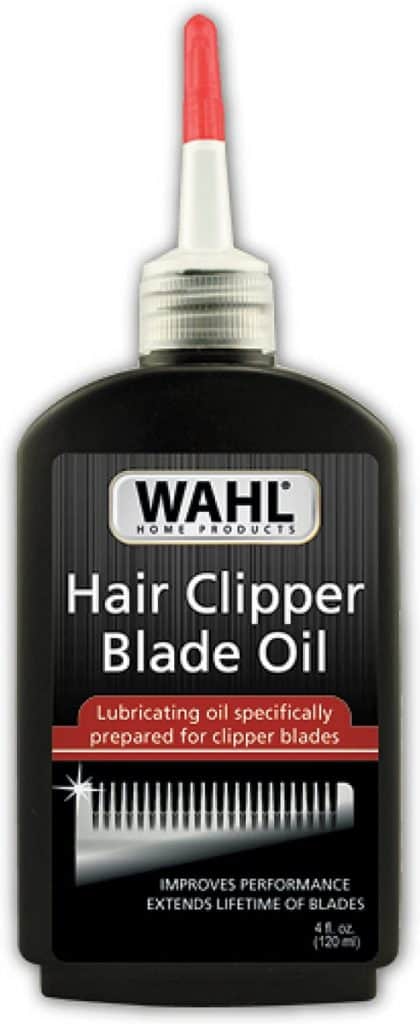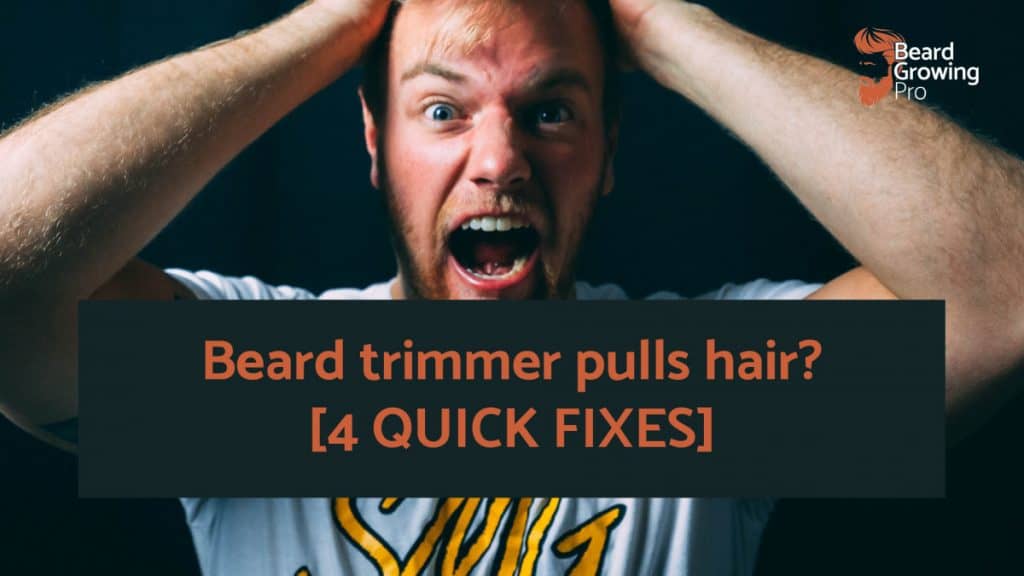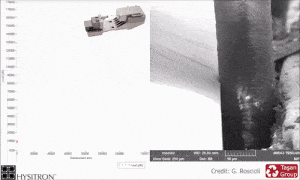One of the most trusted and used parts of a beard grooming toolbox is the beard trimmer. The beard trimmer is my go-to tool to fix almost every problem. I like to use my beard trimmer to not only shape up my beard will also cut in the edges and define the lines of my beard. The problem is that sometimes the beard trimmer pulls hair is to the point that it hurts. If you have recently bought a new trimmer this could be as simple as an alignment issue, or for older trimmers, a little bit of maintenance may stop it from pulling hairs
If your beard trimmer pulls hairs, it could be dulled or damaged blades, a slow motor, or you are using a cheap trimmer. Most issues can be solved by oiling the blades and changing the blades or getting them sharpened. Fully charging the battery before each use will also minimise pulling.
In this article, we are going to go over why your beard trimmer is likely to pull your hair and exactly what you can do about it. You do not have to two suffer through the pain and unpredictability of a bad trimming session.
Before we launch into the issues we need to understand what types of trimmers can be used to trim beards and which issues relate to which type.
Types of trimmer
There are three main types of beard trimmer. Rotary, foil shaver, and Clipper. Each of these types of trimmers have their own issues associated with their use. But Rotary and foil shavers are typically used for stubble beards and lining up the cheek and neck lines.
In the past, I have also purchased a trimmer that contains both foil shaver and clipper types.
The issue with this sort of trimmer is that it tends to do nothing particularly well but is useful in a pinch – if you can’t afford to separate beard trimmers.
Rotary
Rotary shavers typically have three or more cutting heads which conform to the face as you are passing it over your cheeks and chin. Rotary beard trimmers are better for longer hairs that grow in many different directions as the circular nature means it is likely to capture more hairs than a foil shaver.
If you shave less often it is likely that a rotary shaver is going to be better for you as they usually work better with longer hair.
Also, if you are in a rush in the mornings a rotary beard trimmer will enable you to hack away at your face without having to worry about going with or against the grain of growth. It can cover a huge array of areas and is also suitable for shaving your head.
If you’re rotary shaver is pulling at your hair it is likely that the hair is not being cut cleanly as it pokes through the holes in the Rotary guides. Isolating which of the Rotary blades is causing an issue will help you diagnose the problem and create a solution which will talk about more, below.
Foil shaver
A foil shaver is an old school form of shaving and it has a sharp oscillating blade that moves sideways at high speed behind a protective screen that cut the hairs that poke through the perforations in the screen.
Although these types of trimmers are generally used for shaving down to the skin they can be used to line up your beard and cheeks. They are typically suited for sensitive skin and offer the closest shave among all of the trimmers listed here.
They are much easier to control and create defined lines with and so are the perfect accompaniment for your clippers for lining up your cheek and neck line.
They have less moving parts than the Rotary trimmers and are much easier to clean and replace the cutting blades, if you need to.
Clipper
The clipper type of beard trimmer is what most of us will be using to create a stubble beard and upwards. I use my clipper style of beard trimmer a few times a week to get rid of any stray hairs and to keep my beard in a very defined shape and style.
Personally, I use the Wahl pro series trimmers which are corded and one of the best set of trimmers for thick and coarse hair.
The great thing about clippers for styling your beard is that they can do a whole range of different lengths and they are easy to maintain with a simple oiling and DIY clean and blade replace which you can do with a simple Phillips head screwdriver on most models.
Because of the fact that you have two blades oscillating against each other this type of trimmer is likely to have the most number of alignment issues which can cause pulling of the hair.
Here are all of the reasons why any of these trimmers may pull your hair as you are using them.
Reasons your beard trimmer pulls hair
There is nothing more frustrating than being scared of using your trimmers because they are uncomfortable to use and simply wax or epilate the hairs instead of cleanly cutting them.
There are a load of benefits for making sure that your trimmers cut cleanly because a ripped hair is more likely to cause damage further up the shaft over time. Also, regularly waxing the same follicles will cause the hair follicle to become damage and the root of the beard hairs may also become deformed or stop growing in certain follicles.
Dull blades
The first suspect of a beard trimmer pulling hairs is dull cutting surfaces.
If you use your beard trimmer regularly your blades will dull very quickly. Even though the majority of cutting blades in beard trimmers are made from hardened steel the constant high frequency rubbing can quickly chip and dull the cutting-edge of the clippers.
When you first purchase a beard trimmer it is likely that it has been sharpened before selling and the blades move cleanly against each other just like a pair of sharp scissors.
Over time these become dull.
In a recent study by scientists at MIT showed that despite the fact that steel is 50 times harder than human hair it can still chip away the edge of metal razors.
The constant action of cutting a hair can perform the cutting blade in a more complex way than simply wearing down the edge over time. Even a single strand of cut hair can cause the edge of the blade to chip under specific trimming conditions.
The chips in the razor blade were caused when the hair was free to bend during cutting.
When the hair was cut perpendicular to the blade it did not cause any damage. Given the wild and curly nature of beard hairs it is very unlikely that you will always be cutting perfectly perpendicular to the blade.
This study shows that even the hardest of materials – stainless steel coated in carbon or other composite’s – can still be damaged by the much softer beard hairs. This is compounded by use and the more you use your trimmers the more likely the stress chipping at the cutting surface will happen.
Damaged blades
Continuing to use dull blades could damage the blades to the point where there are significant chips and deformities in the cutting surface.
In some of the worst cases of damaged blades that I have seen the trimmer was missing teeth altogether.
Any missing teeth, or damaged blades, can easily cause the hair to become ripped as opposed to cut cleanly. As you are using damaged blades more and more they are more likely to become further weakened and damaged in the same places.
Misaligned blades
All trimmers rely on the passing of cutting surfaces to cut hair. That is, one metallic component moving rapidly over another with hairs being caught in between.
During use of beard trimmers things can get caught in between the blades which slowly moves the blades further and further apart. If the blades do not perfectly rub against each other easily pull out hairs instead of cutting them. Things like small amounts of beard hair mixed with oil as well as metallic shavings can easily push out cutting surfaces by fractions of a millimetre.
Not only do blade cutting surfaces need to be aligned perfectly so that they move freely as close to each other as possible they also have to be lined up horizontally so that the cutting teeth are moving completely over each other with each rotation of the motor.
Some clippers have the ability to extend or retract the cutting surfaces which further embeds the foreign bodies deeper between the blade surfaces.
Rusty interior
Using beard trimming oil regularly can stop rust and degradation from occurring between the blades.
If you have not used a beard trimming oil on your trimmers recently you should do it right away.
As you are trimming your beard small amounts of moisture can easily penetrate between the blades and sit there if they are not displaced by oil.
As the stainless steel surfaces slowly corrode they can also be pushed to misalignment. This further complicates the cutting process and can result in the trimmers pulling out hairs instead of cutting them cleanly.
Slow motor
There is a trend in the beard trimming world to use battery powered trimmers and rechargeable batteries for ease of manoeuvrability during use.
The issue is that the battery can sometimes slow the motor down towards the end of its charge cycle. Personally, I like to use a corded trimmer whenever possible because I can be assured of a maximum power being supplied to the blades and a much more reliable trim.
If you do have a beard trimmer with a battery you should make sure that it is charged up completely and that you look after the battery properly by allowing it to completely discharge every couple of weeks and then recharging it for at least 16 hours overnight.
Towards the end of a rechargeable batteries life – somewhere between 2 to 6 years – it will never purr out the same amount of power and can cause in a sluggish movement between the cutting surfaces. You can overcome this issue by moving the trimmers are slowly as you shave or trim up your beard so that the blades have enough time to do a number of oscillations on smaller parts of your face.
You are turning them off too early
One of the first things that I noticed when I was using trimmers in my beard is that if I was to turn them off too early I would trap semi cut beard hairs in between the blades and as I moved the trimmer away from my face I simply pulled out the hair.
I recommend that you keep your beard trimmers running throughout your entire shave and that you do not turn them off until the trimmer is well away from your beard hair. This means that you are not end up with any trapped semi cut beard hairs which are then pulled out as you remove the trimmer from your face.
Low quality trimmers
Buying low quality trimmers can be a reason why your beard trimmer pulls hair. A low quality beard trimmer can seem like a bargain in the short term but will often cause you problems the more you use it.
A low quality trimmer will combine all of the issues, above, so that it makes it hard to simply tackle one issue. Check out my recommended beard trimmers, at the end of this article, if you want to make sure that you have got the best beard trimmer for your beard type.
Now that we have explored all of the ways that beard trimmers can cause issues with pulling out your beard hair here are the simple solutions for resolving that issue.
Solutions for a beard trimmer that pulls hair
I recommend that you tackle the issue of a beard trimmer pulling out your hair in the order that the solutions are placed. Sometimes a simple oiling is all you need to get your beard trimmer running smoothly again.
Oil after every use
If your beard trimmer is not particularly old you should use trimmer oil to see if you can get the blades moving over the top of each other smoothly.

Sometimes, all it takes is some good quality trimmer oil to loosen up any particles that built up in between the blades causing misalignment issues.
I recommend that you put a couple drops of oil in between the blades after each use or at least once a month.
I like to turn on my trimmers and drop oil on either side and right in the middle and allow the trimmer to run for at least 30 seconds before turning it off.
Sometimes I notice a slight sizzling as I dropped the trimmer oil between the blades and this is the oil displacing tiny bits of hair which have become trapped.
Have the blades sharpened
if you do not want to fully replace the blades you can opt to have the blades sharpened by a professional.
Simply take your beard trimmer, or the blades, to a knife and sharpening expert. They will typically be able to shave and rehone the edges of the blades so that they cut cleanly without ripping the hairs.
Replace blades
A failsafe option for all of the issues is to fully replace the blades. I recommend that you replace the blades every two years of frequent use so that your beard trimming is reproducible and leaves the hairs as cleanly cut as possible.
Replacing the blades also has other benefits such as reducing the time that you need to trim up your beard hairs as you do not need to pass over the same area multiple times to ensure that you have cut it all cleanly.
The last option is to make sure that the trimmer is performing well electrically.
Make sure that the trimmer is electrically sound
Making sure that your trimmer is working well electrically means that the tower is able to be taken from the motor to the cutting edges efficiently.
If you are not sure that your trimmer is working as well as it could you can take it to a device repair technician who will be able to replace some of the internal components such as the carbon brushes for the motor to keep it running smoothly.
If you’re trimmer has a battery you need to make sure that the battery is in a good condition and change the battery every 2 to 5 years. To be honest, that is the average lifespan of a trimmer and in today’s disposable consumer electronic world it is likely that your end up chucking your trimmer in the trash and replacing it with a new rechargeable one.
If you want a more environmentally conscious tool you should aim to purchase one which is corded and repairable. My recommended trimmers are below.
My recommended trimmers
Wahl T-Styler Pro

4.2 out of 5 Stars
This stylish trimmer comes with all of the accessories that you need to get your beard lines looking sharp. This is the first in our T-blade recommendations. The -blade overhang allows you to get nice sharp edges to your beard and also allow you to get the cutting edge really close to your lines.
- Edging – Get crisp clean lines & sharp edges with Wahl’s zero overlap blades; Blades are 0.2 mm and leave a crisp ash line for excellent line definition with the power of a full-size clipper in a easy to hold compact trimmer unit
- Bump-Free Dry Trimming – Edge Pro’s zero overlap precision ground T-blade provides a super close, clean shave without causing razor bumps; High-torque rotary motor & precision machines drive components allow for professional quality shaving at home
- 12 Individual Blade Guards – Edge Pro allows for 12 cutting lengths with included guide combs. Featuring 12 guide combs for haircuts and trims; Included attachment combs range from short (1/8”) to long (1”)
- Durable Wahl Blades – Our high carbon precision ground blades are durable and stay sharp longer than other blades. The high-quality trimmer, clipper, & detailer blades provide smooth hair clipping, beard trimming, beard & neckline detailing, and total body grooming
- The Brand Used by Professionals – Wahl clippers and trimmers have been used by professionals in the salon & barber industry since 1919. With self-sharpening precision blades Wahl clippers, shavers & trimmers deliver a smooth shave
Pros
+ Low skin irritation
+ Sharp lines
+ Long cord
Cons
~ A little bit buzzy
~ No switch to adjust blade cutting height like the pro
Summary
In this article, we have been through all of the reasons why your beard trimmer pulls hair and the simple things that you can do to keep it from causing you any discomfort during use.
A simple oiling and sharpening of the blades may be all that is required for a clean cut. Alternatively, simply replacing the blades allow you to be confident of a reproducible and clean hair cut.





